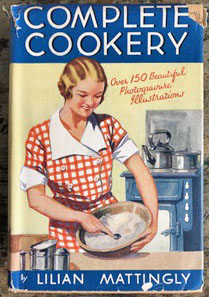Fig and Spaghetti Pudding

In the hope of finding and perhaps reviving some long-forgotten recipes, I have recently purchased several vintage cookery books. According to the inscription, this one was presented to its original owner as a Christmas gift in 1933. I wonder if she (for inevitably it was a her) was as excited as I am to peruse its pages? I imagine her to be just as the lady pictured on the frontispiece, embroidered pinny on, hair neatly finger-waved and stirring something lovely in a Cornishware pudding bowl.
Many of the recipes contained within are as you might expect for the time. Quite a lot of suet going on and tinned pineapple was clearly all the rage. Obviously many of the ingredients we take for granted today were simply not available, but there are plenty of delicious looking things, many of which still feature in a modern-day recipe repertoire. Perhaps the brown and white photography doesn’t show the food off to its best advantage, but that aside, it’s all looking quite promising.
So far, so good. Until we turn to page 119.
I kid you not. Blancmange enhanced with dried figs and, well yes, spaghetti. And out of pure, morbid curiosity I felt compelled to make it.
Ingredients
Half pound dessert figs
Quarter pound spaghetti
1 pint milk
1oz butter
3 dessertspoonfuls sugar
Orange essence, or grated zest of half an orange
¾oz gelatine
Half a gill (70ml) water
It was very straightforward, I’ll give it that. You simply soak the gelatine in the half gill (70ml) water, then stir it into nearly boiling milk. Add the cooked spaghetti (no mention of cutting it up), butter and sugar. Then add the finely chopped figs and grated orange zest. Pour into a mould and leave to set.
The result?
First impression, this pudding is no oil painting, although to be fair, I only had a plain ring tin and not the elaborate jelly mould they would have had me use. That aside though, an opaque beige jelly speckled with fig pips and chunks, with wormlike lines of spaghetti running through was always going to struggle in the looks department.
A very tentative and tiny tip of a teaspoon taste was surprisingly inoffensive. Bland, slightly orangey, certainly not unpleasant. But then I went in for the proper spoonful. And oh my, it’s all about the texture! Gritty fig pieces surrounded by smooth, cold gelatinousness and enhanced with the ever so slightly al dente worms of spaghetti. Utterly. Hideous.
I wonder if the original recipient of the book ever made and enjoyed this recipe? How interesting it is, the way tastes change over time. Maybe one day the spaghetti and fig mould will enjoy a revival, but I think it may have to wait a few years yet. In the meantime, my search for lovely forgotten recipes from history continues.